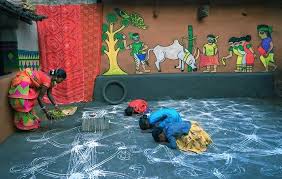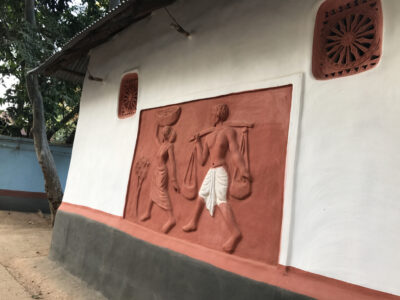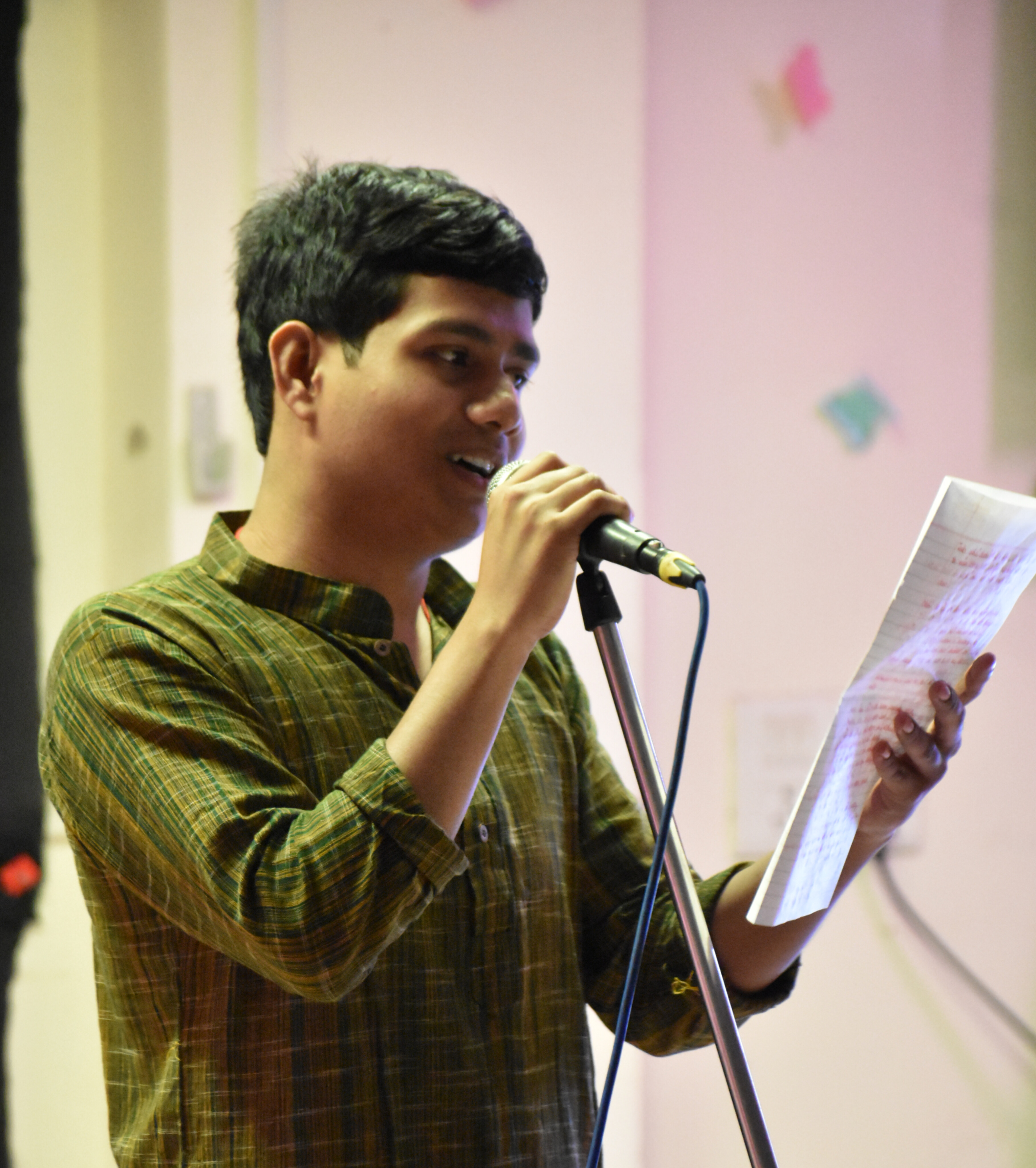
The study of Indigenous art forms and their cultural legacy drives us toward gaining knowledge on the grassroots level of history that shapes that aspect of village or rural society that remained unheard and unseen by the masses due to the domination of elitist history writing. Ranajit Guha was instrumental in founding Subaltern Studies in India, an initiative focused on investigating the historical narratives of marginalized communities across South Asia. The grassroots level of history could be seen and interpreted through various ways, such as art, literature, oral tradition, and various aesthetic forms. One may question why it is important to study indigenous art forms. The answer lies in the rise of cultural identities and actions to preserve them that have contributed to shaping the modern world. This article uncovers one of the most important legacies of Santhal Bhittichitra art that preserved their identity in the modern culture and how it can contribute to understanding the grassroots history and their historical past.

INTRODUCTION
One of the most important as well as largest ethnic groups of India is the Santhal tribes of modern-day Bangladesh and India. Their largest population can be traced to the Jharkhand state of India, and their population can be traced in the other states too, such as Assam, Orissa, Bihar, and West Bengal.
In the quiet rhythms of rural Bengal, where rice paddies glisten in the sun and red laterite paths curve through the forests, lie layers of ingenious history unrecorded in textbooks and unexplored by mainstream art historians. Bengal has always been the hub of historical studies that were being heavily explored, studied, and interpreted, but the ethno-indigenous culture and traditions have been overlooked by many.

Among them, the hidden legacy is the Bhittichitra tradition, a form of mural art practiced by the Santhal community, one of the largest ethnic groups of eastern India. The Bhittichitra art is not merely an art or tradition or a decoration; rather, it serves as a vibrant visual language rooted in ritual, oral memory, and socio-cultural identity.
THE PEOPLE OF FOREST: SANTHALS
To understand the Santhali culture and tradition, one must log in with the Santhals themselves. From the data of the 1996 census, it is being registered that a total of 6.8% of the tribal population of India belongs to the Santhal tribe, and their existence has been calculated from the Aryan period. The prominence of the study of Santhals saw its rise from the 19th century onwards, and the main eye-catching event that made them visible among historians was their role in tribal uprisings against Britishers such as the Santhal rebellion (1885-1856), the Munda rebellion (1899-1900), and the Kol rebellion (1831).
Their main primitive occupation is agriculture, and they heavily depend upon rice cultivation. So, it would not be incorrect to argue that their livelihood was based upon agrarian structure and the main mode of income was rice cultivation. Apart from this, they were also involved in fishing, hunting, and animal husbandry.
They belong to the Proto-Astronoid group and are popular due to their contribution to the 1857 revolt of India. They speak the Santhali language and belong to the Austrosiatic family. They have a written script, ‘Ol-Chiki,’ which includes 30 letters and 5 basic diacritics, which got its precise shape under Pandit Raghunath Murmu in the year 1925. They are referred to as the ‘forest dwellers of India.’ Their lives are deeply entwined with nature, seasonal cycles, and animist spirituality.
In modern-day West Bengal, the districts of Birbhum, Purulia, and Bankura are the important residents of the Santhali tribe who make their livelihood in the villages bordering forests and agricultural lands; the walls of their homes become the canvases for expressing seasonal rituals, harvest celebrations, and mythic narratives. This art practice is part of their material and spiritual world, often performed without the intention of permanence or commercial value.

TECHNIQUES, MATERIALS, AND MOTIFS OF BHITTICHITRA ART
These murals are not ornamental but ritually potent, created during specific times of the year, particularly during Baha Parah (flower festival), Sohari festival (harvest festival), and marriages. They are ephemeral, fading with monsoons and seasons, yet their recurrence over generations forms an evolving visual archive of Santhal’s life.
This kind of art form is traditionally practiced by women, particularly older female members of the household, who learn the techniques informally through observation and participation. The process begins with cleaning and recoating the mud walls by mixing a white soil paste and cow dung. Then it is applied on the walls to make them smooth so the colors could paste properly. This application of cow dung is often seen as sacred, which purifies the household and makes it suitable for ritualistic purposes.
Natural materials are being used as a form of paint, such as red ochre, charcoal black, white from limestone or rice powder, and yellow from turmeric or local herbs. For the application of colors, brushes are being used that are made up of bamboo sticks or animal furs, and sometimes the fiber of date palm. The designs vary, and the use of freehand is promoted. Additionally, women incorporate natural materials like twigs and fabric to apply pigments to their artwork. The freehand method is applied that emphasizes line, geometric patterns, and rhythm. This form of art reflects an intimate knowledge of symbolic forms, passed down orally and experimentally, which shaped social, cultural, and oral history.
Each painted wall tells a story of life or village life in different ways. The main theme is the depiction of village society. The main motifs are
Sun and Moon— they represent cosmic forces and divine watchers.
Birds (especially peacocks)— they symbolize fertility, wisdom, and cosmic balance.
Trees and Forests—It shows the reflection of Santhal’s life and their connection with nature.
Human figures dancing or playing flutes— it represents joy, happiness, positivity, and community bonding.
Abstract geometric borders— marking sacred space and controlling the flow of energy.
These motifs are not merely decorative. For instance, a snake may symbolize both danger and protection, depending on its orientation and accompanying symbols. Thus, the visual syntax of Bhittichitra is layered with metaphysical meanings that are intelligible to the community but often indecipherable to outsiders.

PRESENT-DAY VOICE OF THE BHITTICHITRA ART
Despite the challenges, there are glimmers of revival. Academics and art experts are increasingly focused on chronicling the Santhal’s rich culture and heritage. In a world increasingly driven by digital speed and global aesthetics, Bhittichitra art offers a counter-narrative of slowness, intimacy, and rootedness. It reminds us that art need not be permanent or commodified to be meaningful. For instance, Santiniketan, the abode of peace, represents and promotes Santhali art itself. Gurudev Rabindranath Tagore was influenced by Santhal paintings and art and established an artist colony with assistance from Ramkinkar Baij in 1930. A Santhal family was sculpted near the boundary of Kala Bhavan, Visva Bharati. Even Visva Bharati has a separate Santhali department that promotes the legacy of the Santhals.

CONCLUSION
Bhittichitra is not merely an art form; rather, it is an embodied practice, a form of storytelling, a space of ritual, and a symbol of the community’s intimate bond with its environment. That it remains absent from dominant art narratives is not just a loss for the Santhals, but for all who seek to understand the diversity of Indian aesthetics.
WORKS CITED
Das, Animesh, and Rakesh Rai. “Sohari wall art of the Santhals: A visual chronicle of culture and tradition in the Indian knowledge system.” International Journal of Creative Research Thoughts, vol. 13, no. 3, 2025, pp. 32-40. https://papers.ssrn.com/sol3/papers.cfm?abstract_id=5260161. Accessed 16 June 2025.
“Santhal Paintings | INDIAN CULTURE.” Indian Culture Portal, https://indianculture.gov.in/paintings/santal-paintings/santhal-paintings. Accessed 16 June 2025.
Soren, Priyanka, and Walnueba Jamir. “The Santhals: Their Culture and Traditions.” ResearchGate, vol. 2, 2020, p. 140. https://doi.org/10.22271/ed.book.1014. Accessed 16 July 2025.




